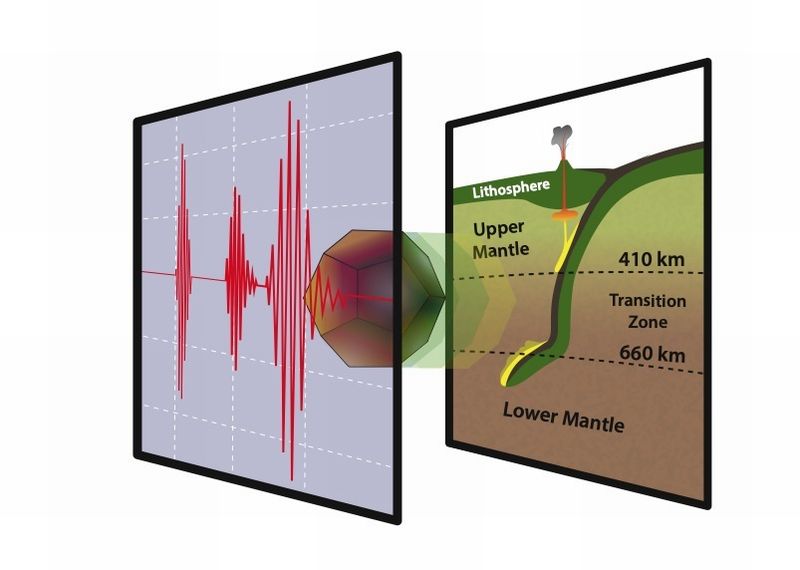The sound velocity of Majorite under mantle transition zone conditions
The fate and behavior of subducting plates into the deep Earth inferred from high pressure and high temperature experiments of MgSiO3 Majorite garnet
Researchers at Ehime University have reported the sound velocity of MgSiO3 Majorite garnet up to the pressure of 18 Gigapascals and temperature up to 2,000 Kelvins. Their results lead to understanding of the mineral composition of the Earth’s mantle transition zone (MTZ), which has not been fully elucidated yet. This study suggests that a mechanical mixture of slab and mantle rocks, rather than equilibrated rocks, is more likely to explain seismological observations throughout the MTZ.
Silicate garnets are important rock-forming minerals which constitute a major part of the Earth’s crust and upper mantle. There are many kinds of silicate garnets composed of a variety of combinations of several elements: silicate, magnesium, aluminum, calcium etc. Among silicate garnets, those called majoritic garnets are garnets enriched in silicon that form exclusively at depths below ~300 km, when pyroxenes, another mineral found in the Earth’ crust and upper mantle, dissolve gradually in garnets from shallower depths. Already in 2008, an experimental study published in the journal Nature by Irifune et al. demonstrated that pyrolite, consisting of ~40 vol.% majoritic garnet and ~60 vol.% olivine (kinds of silicate minerals, (Mg,Fe)2SiO4), is the most representative rock composition at depths of ~560 km in the MTZ. There is, however, still some controversy regarding the upper part of the MTZ, beneath the 410-km discontinuity, and in the deeper MTZ, above the 660-km discontinuity, where mineral physics data cannot explain the steep seismic velocity gradients observed by global seismic studies.
Several hypotheses have been proposed to explain such discrepancies, among them, the idea of variations of chemical composition in mantle garnets has grown in popularity. Because of the contrasting differences in the bulk composition of mantle and slab lithologies, the chemical composition of majoritic garnet is likely to substantially vary across the globe, depending on the geological history of each subduction zone. Interpreting such seismic observations in terms of garnet compositions, however, requires a precise knowledge of the thermoelastic properties of the garnet endmembers in a wide range of pressure and temperature.
MgSiO3 majorite is the most significant endmember of the silicon-rich majoritic garnet family and a major component of majoritic garnets. Knowledge of its thermoelastic properties is therefore of primary importance to derive accurately the seismic velocities of majoritic garnet over a wide range of pressure, temperature and chemical compositions. But, because this phase is only stable in a narrow pressure range, in between ~16 and 22 GPa, and temperatures higher than ~1800 K, making such measurements have been challenging and thus its sound velocities at simultaneous high-pressure and high-temperature have never been determined.
Despite these difficulties, researchers at Ehime successfully measured the longitudinal (VP) and shear (VS) velocities, as well as the density of MgSiO3 majorite, up to 18 GPa and 2,000 K. In the experiments, synchrotron X-ray techniques were combined with in situ ultrasonic measurements at high pressure and temperature, in the multi-anvil apparatus located at the beamline BL04B1 in SPring-8 (Hyogo, Japan). They used a synthetic rod of MgSiO3 enstatite, a low-pressure form of MgSiO3, to synthesize the majorite sample at high pressure and high temperature, from which they directly measured its sound velocities in the multi-anvil press.
The results of their experiments showed that majorite has the smallest bulk and shear moduli among those of the major garnet endmembers at the pressures and temperatures of the Earth’s MTZ, suggesting that elastic softening is likely to occur in mantle garnets when majorite-content increases with increasing pressure (with going deeper). The results further predict that the shear elastic properties of Ca-bearing majorite may be more sensitive to cation ordering/disordering than other majoritic garnets, which could give rise to a wide variety of shear elastic anomalies across the transformation of cubic garnet to tetragonal majoritic garnet in natural compositions.
The increase of majorite content in mantle garnets would contribute to slowing down the subducted slab in the middle part of the MTZ. The increase could also play a role along with the partitioning of Fe in olivine/wadsleyite or partial melting, to interpret the observed velocity jump at 410 km. Compositional changes in majoritic garnet are, however, unlikely to affect the seismic profiles above the 660, which are more subject to change by the appearance of CaSiO3 davemaoite or the Fe partitioning in (Mg,Fe)2SiO4 components. These new data should greatly contribute to tracing the existence and recycling of the former subducted lithospheric crust and the fate of the subducted slab in the Earth’s MTZ.
Reference URL: https://agupubs.onlinelibrary.wiley.com/doi/10.1029/20
Bibliographic Information
Sound velocity of MgSiO3 majorite garnet up to 18 GPa and 2000 K
Chunyin Zhou, Steeve Gréaux, Zhaodong Liu, Yuji Higo, Takeshi Arimoto, Tetsuo Irifune
Geophysical Research Letters, 48, e2021GL093499
doi: 10.1029/2021GL093499 (15 July, 2021)
Fundings
- SPring-8 Power User Research Proposals Number 2012B0082
- Japan Society for the Promotion of Science (JSPS) KAKENHI Program Number 25220712
Media
Contact Person
Name : Steeve Gréaux
Phone : +81-89-927-8405
E-mail : greaux@sci.ehime-u.ac.jp
Affiliation : Geodymamics Research Center(GRC)


